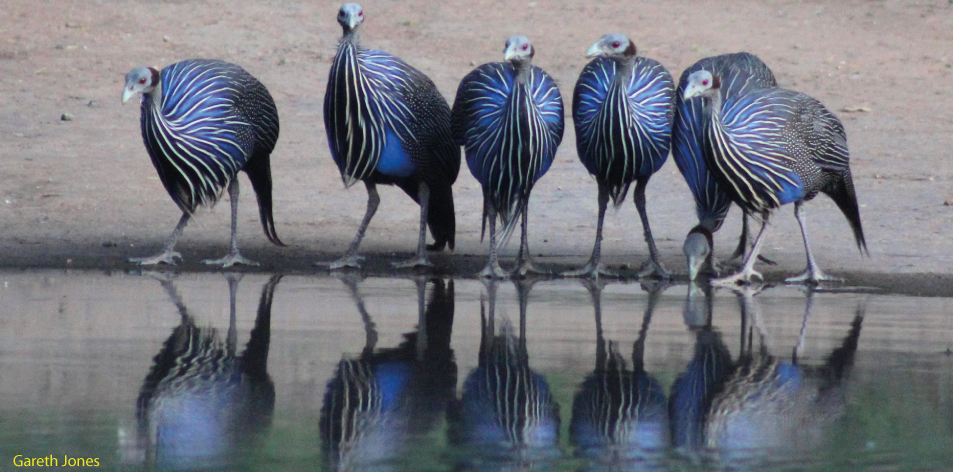
The ‘Bluetiful’ Guineafowl!! – Article by Gareth Jones
The “Bluetiful” Guineafowl Of Africa
We awoke early before sunrise and prepared for a morning game drive in the Meru National Park. Departing just before sunrise, we soon arrived at a low river crossing bridge, then suddenly as we reached about the midpoint on the bridge, a flash of blue emerged from the river bushes. WOW! It was a small flock of vulturine guineafowl. I immediately switched off the engine and waited on the bridge as water flowed under our vehicle. As we quietly waited the vulturine guineafowl walked to the edge of the river and began to drink. The “Bluetiful” sight of their vivid cobalt blue plumage was significantly enhanced by the soft light of the sunrise rays as they lingered on the water’s edge. After a short while, they slowly moved away as they began their daily activities including foraging for tasty snacks on the ground. What a memorable start to our day, and even years later remains a special memory for us. For the record vulturine guineafowl are the tallest of the guineafowl species being up to 70cm tall.
There are actually six known species of Guineafowl in Africa with Kenya being blessed to have three of them, namely the Crested Guineafowl, Vulturine Guineafowl, and the Helmeted Guineafowl sometimes called “speckled hens” are birds of the family Numididae in the order Galliformes. They are endemic to Africa and rank among the oldest of the gallinaceous birds. Guineafowl species are found across sub-Saharan Africa, some almost in the entire range, others more localized, such as the plumed guineafowl in west-central Africa and the vulturine guineafowl in north-east Africa. They live in semi-open habitats such as savanna or semideserts, while some, such as the black guineafowl (found in west-central Africa), mainly inhabit forests. Some perch high on treetops.
Guineafowl play a major role in the process of reducing pests such as ticks. Ticks carry a number of diseases, including African tick bite fever, tick-borne relapsing fever, babesiosis, and tick paralysis. Microbiological pathogens can cause serious disease especially in a weakened host and can even result in death. One recorded case is the death of the famous lioness “Elsa”, who died in the Meru National Park after fighting with other lions, and then having a weakening immunity became infected with tick bite fever due to not having resistance to the babesia leo protozoan parasites. It can even be said that Guineafowl are indirectly one of the best friends that lions could ever have, even though all lions are completely unaware of the benefit they have from the actions of guineafowl. The guineafowl eat thousands of ticks that are not on animals, by continuously searching and scratching on the ground. Next time you see guineafowl you will hopefully appreciate them more due to their special role in pest reduction, and improving the health of species like lions.
The helmeted guineafowl (Numida meleagris) is the best known of the guineafowl bird family, they are widely found in many parts of Kenya, including being well represented within the Nairobi National Park as the sub-species of helmeted Guineafowl known as “Reichenow’s Guineafowl”, (Numida meleagris reichenowi), showing characteristically bright, tricolor head pattern of the orange-brown casque, bright aqua “bluetiful” cheek and neck, and red “handlebar moustache”. It is interesting to note that there are actually nine recorded sub-species of helmeted guineafowl across Africa. While they are thriving in the park, they are themselves also targeted prey of Serval cats and leopards. They are a gregarious species, forming flocks outside the breeding season typically of about 25 birds that also roost communally. As already mentioned guineafowl are particularly well-suited to consuming massive quantities of ticks, which might otherwise spread Lyme disease. These birds are terrestrial and prone to run rather than fly when alarmed. Like most gallinaceous birds, they have a short-lived explosive flight and rely on gliding to cover extended distances. Helmeted guineafowl can walk 10 km and more in a day. Their bodies are well-suited for running and they are remarkably successful in maintaining dynamic stability over rough terrain at speed. They make loud harsh calls when disturbed, and can at times result in the sighting of a predator like a serval cat for those who listen and then wait and observe. Remarkably the Nairobi National Park also has the very rarely seen forest Crested Guineafowl (Guttera pucherani) resident within the park.
Yes, the “bluetiful” guineafowl can be very rewarding for those who take the time to slow down and watch their activities, particularly in the early mornings and late afternoons.


